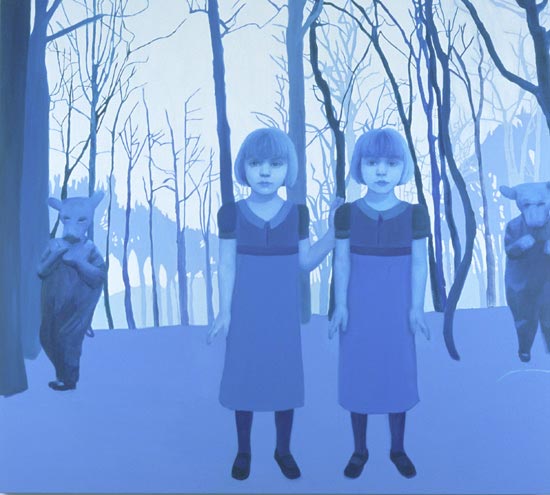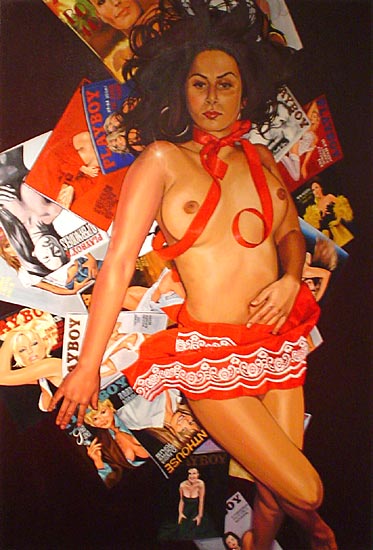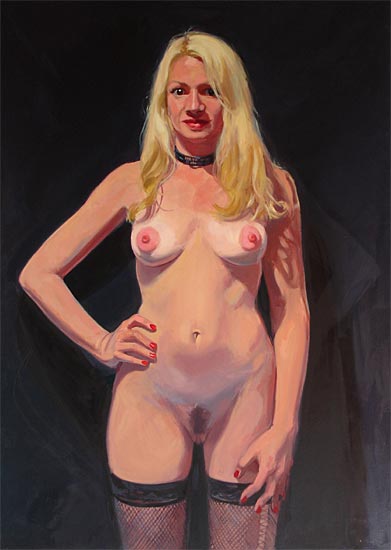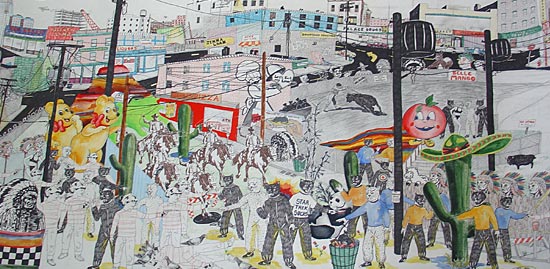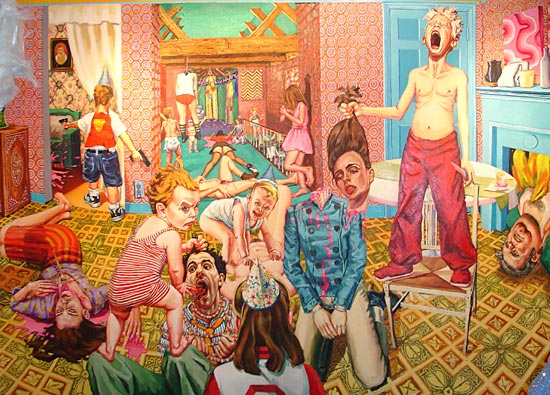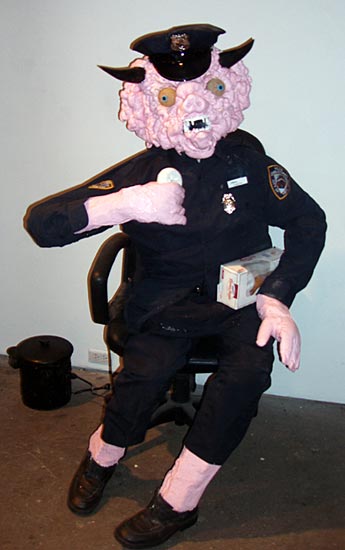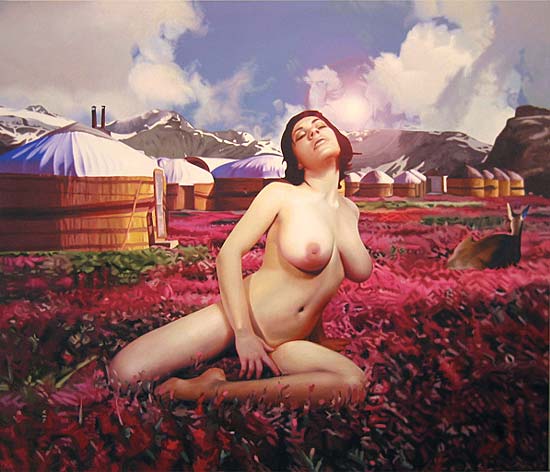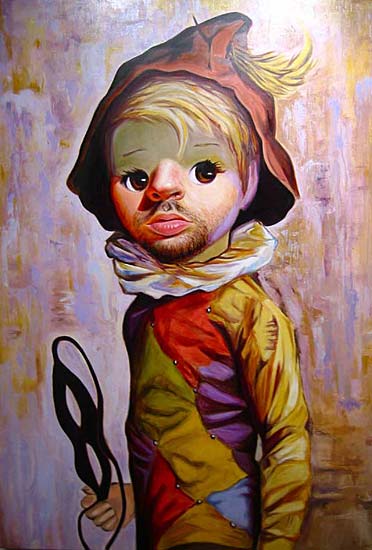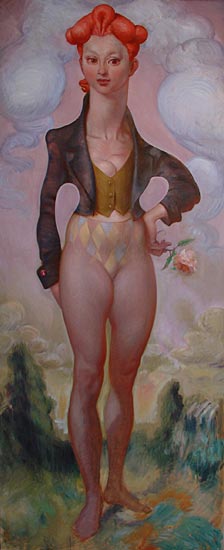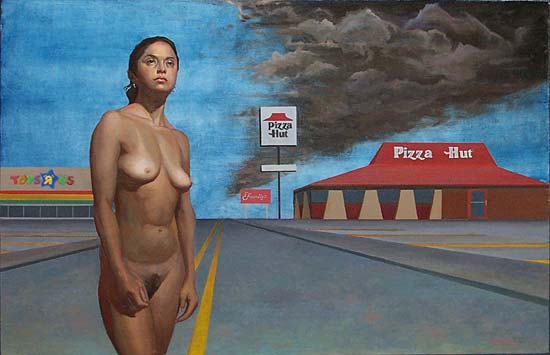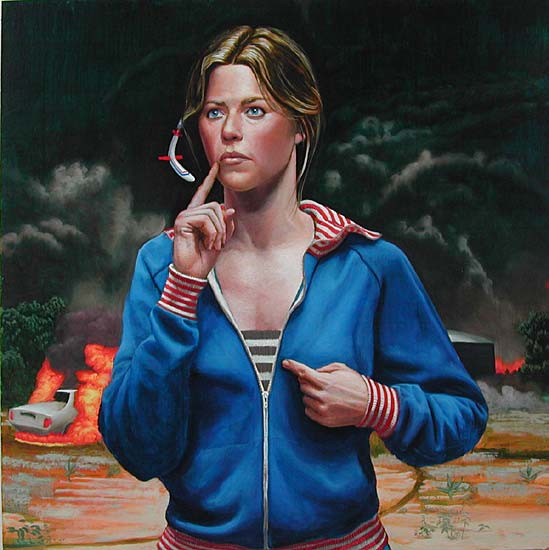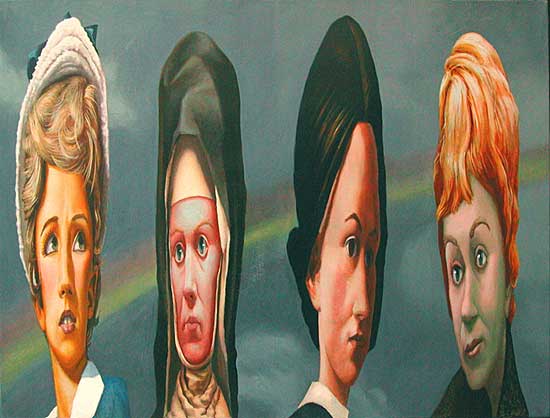Heather Marx Gallery in San Francisco
http://www.heathermarxgallery.com New Work by
DAVID HEVEL "PopoZao"
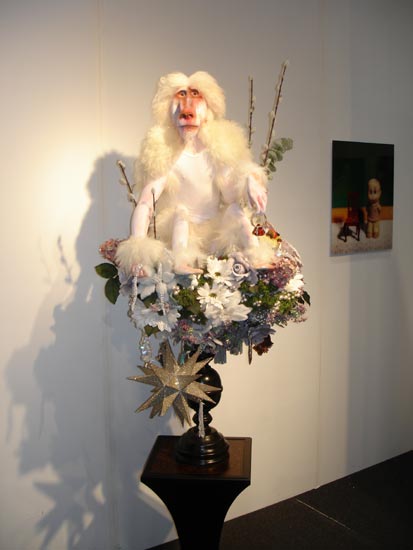
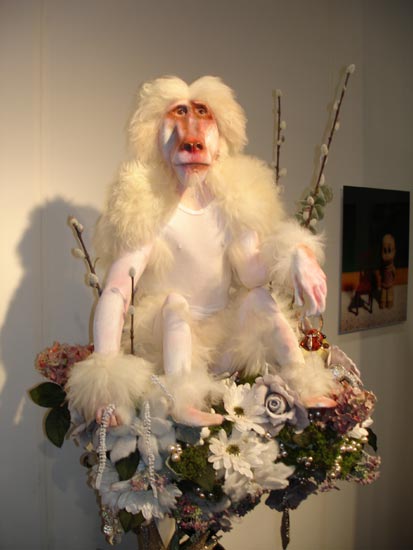
"Mr. Smith in Quarantine"
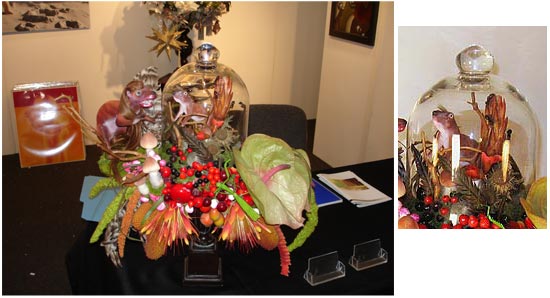
Work by
DAVID HEVEL "Take My Breath Away"
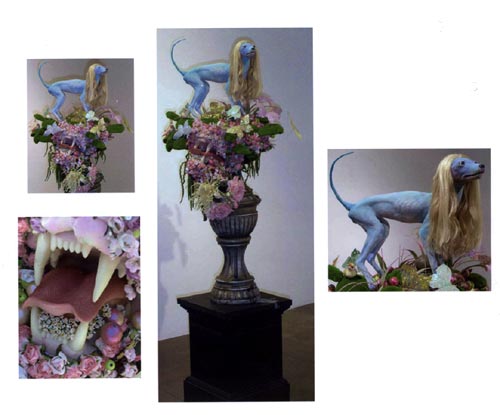
Artist's Information
David Hevel's over-the-top constructions employ taxidermy, props, and craft supplies to create ribald sculptures and installations that borrow their titles from celebrity tabloids. For the exhibition, Hevel will feature his own version of Bambi on ecstasy, tentatively titled It's Official…Britney's Pregnant!, featuring a 6-foot tall deer -- leaking plastic "milk" from multiple breasts -- leaping through a beautiful garden of flowers, ribbon, and rhinestones. Hevel's work is wickedly humorous, and combines elements of science fiction, horror, and an often macabre twist on Martha Stewart-style homemaking. The results are luscious and beautiful send-ups to all that glitters.
Hevel received his MFA from the California College of Art in San Francisco in 2002. His work has been exhibited at the Richmond Art Center, Richmond, CA; The Works Gallery, San Jose, CA; HereArt, New York, NY; Southern Exposure and the San Francisco Art Commission Gallery in San Francisco, CA, among other venues. Hevel was also a recipient of the Murphy/Catagan Fellowship Award from the San Francisco Arts Foundation in 2001.
Artist's Bio
DAVID HEVEL
Education:
2002 California College of Arts and Crafts, San Francisco, CA
MFA, Film/Video Performance
1998 M.Ed., Curriculum and Instruction University of Missouri, Columbia, MO
1993 Central Missouri State University, Warrensburg, MO
BFA, Commercial Illustration and Studio Painting
Selected Exhibitions:
2006 “Fantasy Island 2,” Drake Hotel, Toronto, ON
2005 “Beautiful Debris,” Heather Marx Gallery, San Francisco, CA (travelling to Cypress College Fine Arts Gallery, Cypress, CA)
“Material Matters,” The Lab, San Francisco, CA
“Nancy Boy,” Richmond Art Center, Richmond, CA
2004 “Build: An eight-hour Performance Event,” The Works Gallery, San Jose, CA
2003 “SanFranBananas,” Whitney Cultural Center, San Francisco, CA
“Queer Art,” San Francisco LGBT Center, San Francisco, CA
“Fresh: Redefining Queer Aesthetics,” San Francisco LGBT Center, San Francisco, CA
“Boutique,” Blackbird Space, San Francisco, CA
“Fictional Science,” HereArt, New York, NY
“Poplular TM,” The Works Gallery, San Jose, CA
2002 “Repurpose,” Southern Exposure Gallery, San Francisco, CA
“Punked,” Monart Gallery, Walnut Creek, CA
“Extravaganza,” Paulette Long and Shepard Pollack Gallery, San Francisco, CA
“1111,” California College of Arts and Crafts, MFA Graduate Exhibition, San Francisco, CA
“Fuel,” Paulette Long and Shepard Pollack Gallery, CCAC, San Francisco, CA
“Warrior Games,” Paulette Long and Shepard Pollack Gallery, San Francisco, CA
“Re-enactment of Voyage to the New World,” Artist Event, Oakland, CA
2001 “Voyage to the New World: 1st Fabulous Party after 9/11,” Artist Event, Oakland, CA
“Murphy-Cadogan Scholarship Award Exhibit,” San Francisco Arts Commission Gallery, San Francisco, CA
“Museum of Future Atrocities,” ATA, San Francisco, CA
“CCAC Video and Writers Showcase,” CCAC, San Francisco, CA
“BioRave: Biotech Benefit for the Coalition of Artist and Other Life Forms,” ATA, San Francisco, CA
1997 “FiberWorks,” Legacy Gallery, Columbia, MO
“Graduate Exhibit,” Bingham Gallery, Columbia, MO
“Fiber In/Forms,” Mabee Atrium Gallery, Culver-Stockton College, Canton, MO
1996 “Curator of Graduates in Fibers,”Brady Gallery, University of Missouri,
Columbia, MO
“Kimonos and More,” Legacy Gallery, Columbia, MO
1995 “Best of Show: The Mid-Missouri Computer Animation Festival,” University of Missouri, Columbia, MO
1992 “Works on Paper,” Milwaukee Art Institute, Milwaukee, WI
“Kansas City Regional Coalition of Higher Education Art Exhibition,”
Kansas City, MO
Selected Bibliography: 2006 Cash, Stephanie, “Report from San Francisco II: New and Now,” Art in America, January, p. 60, 62
2005 Berry, Colin, “ 'Material Matters' at The LAB,” Artweek, September, p. 14
Helfand, Glen, “Critic's Picks: Beautiful Debris,” artforum.com, August
Bing, Alison, “Good and Trashy,” SFGate.com Art ePick, July 28-August 3
Nataraj, Nirmala, “ 'Nancy Boy' at the Richmond Art Center,” Artweek, May,
p. 15
Taylor, Robert, “What the Peeps is going on? Examples of 'New Pop Art' are all over the Bay Area,” Contra Costa Times, February 6
New Work by
FORREST WILLIAMS "Street(3)"
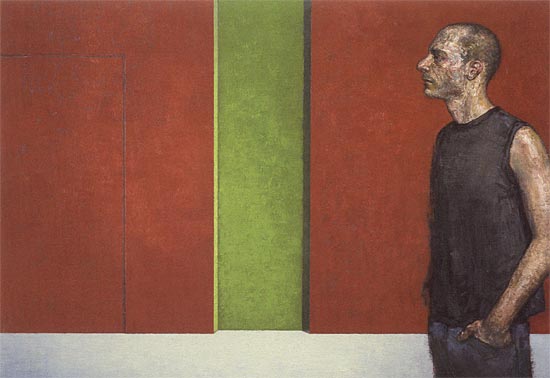
Press Release:
Heather Marx Gallery is pleased to announce New York artist Forrest Williams' eagerly anticipated second solo exhibition Passage, which will feature life-size oil on canvas and small oil on panel figure paintings. Unlike his 2002 show Interiors, in which Williams' figures rarely touched or looked at each other, this new body of work explores more subtle, self-conscious attempts at connection between his subjects. "There is more of an intensification of reality, a concentrated moment of charged yet restrained feeling, within the anonymous spaces of these paintings," according to the artist.
New as well is the absence of the subdued and patterned color schemes of Williams' earlier work. An artist exchange stint in Southern California provided the initial inspiration for his solid, Mondrian-esque backgrounds of vibrant reds, greens, and blues. Later, Williams discovered that this amplified color was effective as a way to highlight -- and even dominate -- the figure, acting as a metaphor for the intensity of feeling his subjects exude. These areas of bold color also serve to create ambiguous sets seemingly outside in the street or a deserted alley, suggesting that while his subjects have begun to tackle a self-imposed isolation, they are doing so alone and somewhat hidden from view.
In a series of small Bridge diptychs, two men reach out for each other in tentative handshake poses -- their actual contact only interrupted by the tiny space between the panels themselves -- suggesting the subtle, yet profoundly awkward, separations in our relationships. In his life-size paintings, Williams further expands on this series. He has created both two panel and single canvases, such as Diver and (Green) Alley, that are a visual treat of primary color contrasted with restrained, almost reticent, male figures. Strikingly gorgeous and rich with surface texture, Williams' paintings have been described as "young men caught in the cool directional light, turbulent stillness, and psychological intrigue of a 17th-century Flemish painting," by art critic and writer Alison Bing.
Williams received his MFA from The New York Academy of Art in 1994. He was recently featured in the well-received exhibition Re-presenting Representation 6 at the Arnot Art Museum in Elmira, NY and has had solo and group shows at Elizabeth Leach Gallery in Portland, OR, Wallspace in New York City, and Gallerie de Bellefeuille in Montréal, Quebec. His work has been reproduced in Harper's Magazine and Genre, and was reviewed in Art & Antiques magazine, the Portland Mercury, and on SFGate.com.
Catalogue:
Forrest Williams: Thisclose
Come close; no, closer; closer still; now hold it right there. This is the point of departure for a Forrest Williams painting: An exquisitely untenable situation that's too close to be casual, and yet too far away to be truly intimate. Hands reach out only to hit the edge of the canvas. Heads turn to meet a glance a second too late. Figures lean toward one another, but never quite touch. You're drawn into a state of suspended animation, uncertain whether to approach or retreat, blush or blanch.
Is this a painting, or a tango? Williams draws much of his inspiration from dance, and it shows. In Diver, one man prepares to leap while the other one lights up; both actions seem contrived, choreographed, a feigned disinterest in each other's actions that's a dead giveaway of deep yearning. But these figures are not posed; they're paused, caught in a moment's hesitation that is only suggested on the face but seems to leave every muscle tense. "We tend to think of inaction as the course of least resistance, but any dancer will tell you that staying still takes as much muscle control as making a movement," explains Williams.
He's onto something here. In a society that continues to constrain intimacy -- especially between men -- every attempt to connect is a real and meaningful stretch. The sleeveless T-shirts and rumpled, unbuttoned shirts of Williams' models indicate that we've shed some formalities since the Victorian days of high collars and gloves. But still these manly encounters do not seem casual at all; they're charged with their own expectations, hopes, and fears, and everyone else's besides. The colors of Williams' paintings are bold and exuberant, but the men are not; their lips are sealed, and their brows bend under the weight of too many words left unsaid. In (Red) Alley, even a tentative handshake is prevented by a split right down the middle of the canvas. Kiss is unthinkable; where another pair of lips should be, there's a wall instead. "There may be only a quarter of an inch separating them, but there's no getting past the edge of that canvas," Williams says. There are echoes here of the political climate: Intimacy among men doesn't always come easily, but now there are structural limits imposed on those relationships as well.
Forget about safe distances and easy rapport - Williams' paintings are not about to give in to strict, distancing formalism or to loose, familiar abstraction. Street (2) is a minimalist painting that just so happens to be inhabited, the delectable green brushwork interrupted by a man leaning forward intently as though straining to hear someone just out of earshot. This scene may not be familiar, but this guy's less-than-ideal position certainly is: it's the repressed urge to join in a conversation at a busstop, that seizure of self-consciousness outside a club. He's literally out of step with the perfect geometry of his surroundings, and the taut emotions stippling his face complicate the broad brushstrokes. This is the dilemma of minimalism and modernity: A Rothko can be a lovely place to visit, but we don't live in that ideal, depopulated world. We need human contact; we keep striving for it, against all odds. There's a certain beauty that deserves to be recognized in that too.
Alison Bing, February 2005
Alison Bing is an author, art critic, and independent commentator for Artweek, San Francisco Chronicle's online edition (SFGate.com), artUS, Sculpture, CMYK, Bidoun, and other arts magazines.
New Work by
DAVID LYLE "Best in Show"
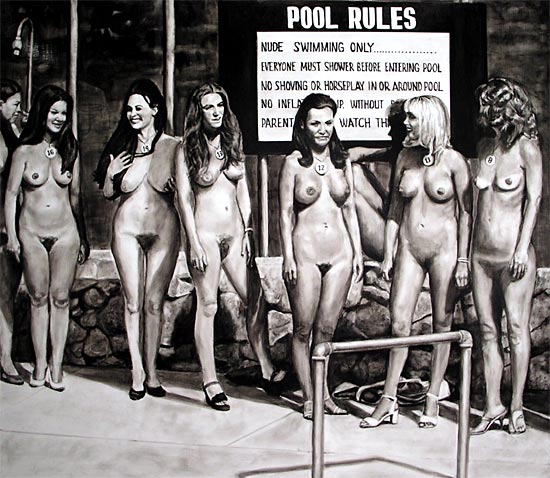
Artist's Statement:
My paintings are inspired from found photos or discarded memories. I feel that to find a lost photo and paint it, allows the photo and the memory to have a second life. Although I don't know the people in the paintings, I can relate to certain memories and times in my own life.
By using black and sepia tones, the paintings take on a nostalgic or cinematic mood and I generally try to keep a voyeuristic feel to them, as if the subject or subjects are unaware that they are being watched. I try to keep my paintings realistic yet somewhat hazy, just like memories can be.
Other Information:
Heather Marx Gallery is pleased to present David Lyle's second solo exhibition, February 17 through March 26, 2005. In Fame, Lyle has exposed -- with compassion and humor -- the seductive notion of fame, especially as it relates to middle class America. As in his previous show Sunday, Lyle acts as both curator and painter, sifting through a vast array of snapshots from the 1950s, 60s, and 70s found at thrift stores, garage sales, e-bay auctions, and flea markets. Barely altering the compositions, he bases his black-and-white oil on panel paintings on these images, mimicking their found photo authenticity and achieving a sense of nostalgia and memory. In addition, an in-gallery floor installation of found trophies and awards is also planned.
For Fame, Lyle began noticing themes in amateur family snapshots representing, for example, a blue-ribbon winner at a county fair baking contest, a bowling team posing with their winning trophy, and a small-town beauty queen winning her crown. The notion of fame is not unfamiliar; it has captured the imagination of countless people over the centuries including Leonardo da Vinci, Oscar Wilde, and Andy Warhol, to name a few. However, by focusing on imagery drawn primarily from small town America in the 1950s and 60s Lyle's humble portraits recall a nostalgic past in which the cult of fame had not reached its present cynical pitch, where celebrity can be as complex as Marlon Brando or as vacuous as Paris Hilton.
Not only are Lyle's images compelling in themselves, but in selecting themes from a dense amount of images Lyle extracts a purely American moment in our psyches. It is this blend of curator and painter that is so interesting in Lyle's work, allowing him to create a formidable sense of familiarity with his subjects. As we gaze at the proud faces clutching their trophies and ribbons, we recognize at once the fleeting nature of these awards, of fame, and most poignantly, the quest for the American dream and its imminent disappointment.
Lyle received his degree in Studio Painting from the College of Creative Studies at the University of California, Santa Barbara in 1994. His work has been featured in solo and group exhibitions at George Billis Gallery in Los Angeles; at Adobe Bookstore, George Krevsky Gallery, and 111 Minna in San Francisco; and at Greenwood/Chebithes Gallery in Laguna Beach. Lyle's work has been featured in Artweek, ARTnews, New American Paintings, and the San Francisco Bay Guardian, among other publications.
BRIGETTE BURNS "Jack Rabbit"
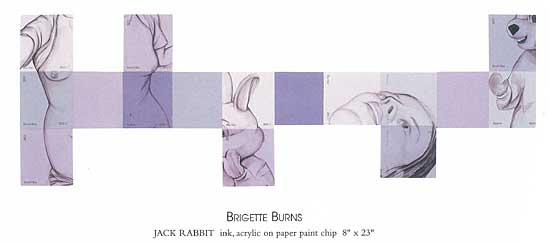
Other Information:
Los Angeles artist Brigette Burns debuts a new series of compelling ink and brush drawings on painted paper (paint chips) in her second solo exhibition at Heather Marx Gallery from July 8 through August 14, 2004. Whereas Burns' earlier drawings were comprised of found imagery from commercial sources, these new drawings represent images of people, objects, and places drawn from the artist's personal history. Through this unique visual language, Burns creates intimate images that hauntingly reconstruct her recent past.
Burns no longer relies on the paint chip titles as the catalyst for her imagery. Instead, she now uses the paint chips to build a surface of abstract color on which to lay her forms, erasing all traces of text from the chips. The result is her beautifully deft drawings taking center stage. Her Romanticized titles such as The Memory Suddenly Revealed Itself, The Moment Before, and Breathing Room allude to her new exploration of a more personal state of mind. After creating several drawings on the individual painted paper, the drawings are then, according to Burns, "taken apart repeatedly without rearranging the images in a linear timeline or a narrative of an exact event." By shuffling her elements in this manner, Burns ultimately reveals the memories of a past emotional or mental state.
The artist continues to play brilliantly with the relevance of narrative and compositional structure in her work. A sequence of chips, either horizontal or vertical, will often be interrupted by blank spaces that mimic her cropped subjects. Such spaces offer holes in the narrative, whereby the viewer is challenged to visually "fill in the blanks." Just as Burns reconstructs paint chips in a myriad of constructions, so too is memory reprised, rethought, and ultimately revisited. Not only has Burns demonstrated her command of the medium of brush and ink, she has also succeeded in producing a body of work that is playful, sexy, contemplative, and very much a portrait of herself.
Burns was a recipient of a California Arts Council Grant in 2003 and has shown extensively, including a solo show at Acuna-Hansen Gallery in Los Angeles, the traveling show Representing LA at the Laguna Art Museum in Southern California, and Shores Space in Amsterdam, among others. Her work has been reviewed and featured in Contemporary, the San Francisco Chronicle, SFGate.com, the Orange County Register, the Orange County Weekly, Artweek, and New American Paintings. Her work is also featured in several private and public collections, including the JP Morgan Chase Art Collection in San Francisco and New York. Burns received her BA from New York's Hunter College in 1990.
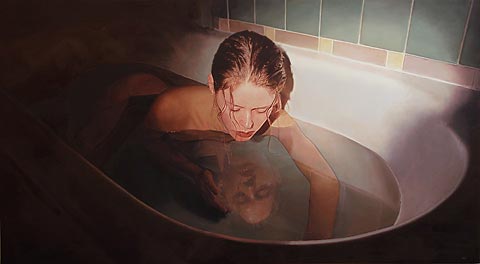








 Other Information: Los Angeles artist Brigette Burns debuts a new series of compelling ink and brush drawings on painted paper (paint chips) in her second solo exhibition at Heather Marx Gallery from July 8 through August 14, 2004. Whereas Burns' earlier drawings were comprised of found imagery from commercial sources, these new drawings represent images of people, objects, and places drawn from the artist's personal history. Through this unique visual language, Burns creates intimate images that hauntingly reconstruct her recent past.
Other Information: Los Angeles artist Brigette Burns debuts a new series of compelling ink and brush drawings on painted paper (paint chips) in her second solo exhibition at Heather Marx Gallery from July 8 through August 14, 2004. Whereas Burns' earlier drawings were comprised of found imagery from commercial sources, these new drawings represent images of people, objects, and places drawn from the artist's personal history. Through this unique visual language, Burns creates intimate images that hauntingly reconstruct her recent past.